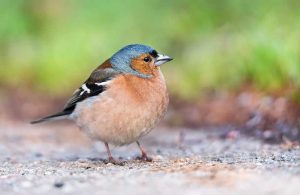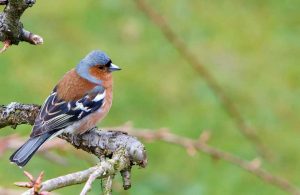Chaffinches are in abundance in the UK I am led to believe, but they seem to be one of the least frequent visitors to my garden.
They are fairly shy and prefer to hide amongst the branches of shrubs and trees, particularly conifers if you have them.

They might be small but have loud voices, they are capable of picking up regional accents.
Sometimes, their call gets louder, which made me wonder, ‘are chaffinches territorial‘, and is their call part of their defence.
During the breeding season, the chaffinch is extremely territorial. Whether the mated pair have chosen to make their nest in deciduous woodland, or a tall, bushy shrub in a garden, the male chaffinch keeps watch as the female incubates and feeds the hatchlings. At the first sign of danger, he increases the volume of his song, making it sound more urgent and aggressive. This is usually enough to warn other birds that they’re encroaching on his territory.
Table of Contents
Are chaffinches territorial during the winter
As soon as the climate changes for the worst, the female chaffinch often heads south in search of slightly warmer weather. This doesn’t perturb the male, he will stay in the region of their territory, protecting it until her return in the early spring.
Although chaffinches flock together in large groups during the winter, usually to plunder seeds and fruit from farmland, the male often returns to roost in his territory, ensuring his claim is staked.
Do chaffinches nest in gardens
They love beech trees but will make their home in wooded parkland with healthy trees of almost any variety.
The hunt for food often drives them into gardens, and if your garden is blessed with lots of greenery, tall shrubs or trees, chaffinches may make it their territory.
To attract them, try scattering specialist seed mixes, sunflower hearts, or suet pellets on the ground. Chaffinches prefer to eat from ground feeders, finding hanging ones far too awkward to manage.
The chaffinch breeding season
If the winter has been mild, the breeding season might start as soon as early February. The male will choose a territory and seek the approval of a female chaffinch.

If she likes it, she will do the majority of the work building a deep-cup nest. It is the female that incubates the eggs and collects some of the invertebrates to feed the young.
All of this happens as the proud new father perches close-by, protecting his territory from possible coups and would-be predators.
Finally…
Chaffinches are territorial, and they hold their territory year-round once they are part of a breeding pair.
If you’re lucky enough to have them nest in your garden, providing their brood is successful, prepare to see the pair of chaffinches reunite in early spring of each year.
You may need to wear earplugs to drown out the excessively loud song of the male if any other bird dares to step into their territory.
